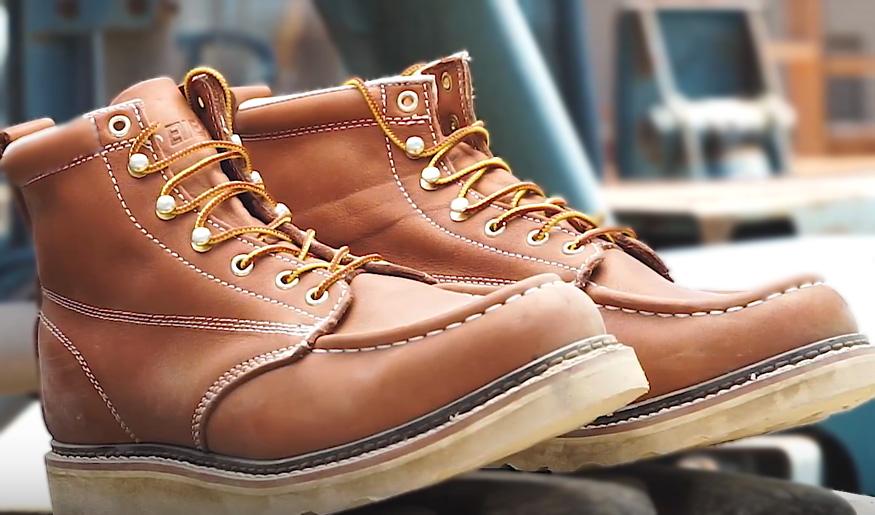
How do you break in new work boots without discomfort?
It’s important to break in new work boots because it can have a big impact on your comfort and productivity. Unworn boots are frequently stiff, which can make them uncomfortable to wear and lead to blisters and irritation.
However, with the appropriate techniques and determination, you can lessen the discomfort connected with this procedure and guarantee that your boots offer the stability and security you require for your regular activities.
In this article, we’ll look at useful advice and methods for breaking in new work boots painlessly and comfortably, so you can concentrate on your work rather than your shoes.
How do you break in new work boots without discomfort? – A guide
To make sure new work boots are cozy and offer the right support during long shifts on the job, breaking them in can be a critical step. Here are some pointers for breaking in new work boots painlessly:
- Wear them around the house:
Start by wearing your new boots around the house for short periods to get used to the feel. This will help identify any pressure points or areas that may need special attention.
- Use thicker socks:
Wear thicker socks or multiple pairs of socks to add some cushioning and reduce friction between your feet and the boots. This can help prevent blisters.
- Gradual wear:
Initially, wear your new boots for shorter periods and gradually increase the duration as they become more comfortable. This allows your feet to adapt to the boots slowly.
- Moisturize the leather:
For leather boots, you can use a leather conditioner or boot oil to soften the leather and prevent it from cracking. This can make the boots more flexible and comfortable.
- Use boot stretchers:
Boot stretchers are devices that can be placed inside the boots to stretch them slightly, helping to alleviate tightness in specific areas.
- Heat-molding:
Some boots are designed to be heat-molded to your feet. Follow the manufacturer’s instructions to heat them properly and then wear them until they cool and conform to your foot shape.
- Padding and insoles:
If you have specific pressure points or discomfort, consider using padding or cushioning inserts to relieve pressure and provide additional support.
- Walk on different terrains:
To put on the conditions you’ll encounter at work, take your boots for walks on various terrains like grass, gravel, or uneven surfaces. This can help the boots break in more naturally.
- Pay attention to hotspots:
If you notice specific areas causing discomfort, address them with techniques like rubbing alcohol or water to soften the leather and then wearing the boots to mold them to your feet.
- Regular maintenance:
To guarantee that your boots last longer and continue to be comfortable, keep them clean and well-maintained. Regular conditioning and cleaning of leather boots may keep them flexible and comfortable.
Keep in mind that it may take some time to break in new boots, and it’s crucial to put your comfort and foot health first. After attempting these fixes, if your boots are still uncomfortable, you might want to talk to a professional cobbler for additional tweaks or guidance.
How do you make breaking in boots less painful?
Although breaking in boots can be an uncomfortable process, there are things you can take to lessen discomfort and ease the transition. First, make sure the boots you select are the appropriate size and style for your foot. During the break-in process, painful boots may become worse. Make sure your toes have enough room in the boots you buy, and that the arch and heel support are appropriate for your foot type.
In order to add an extra layer of protection while your shoes are breaking in, you can also put moleskin or blister patches to any possible trouble spots on your foot. By taking these actions, you can greatly lessen the pain and torture of breaking in new boots, making the process more tolerable.
Finally, throughout the break-in stage, go slowly and be patient. Wear your new boots for gradually longer periods of time, and refrain from demanding activities until they are more at ease. They will adapt to your feet better the more you wear them. By keeping these tips in mind, you may lessen the discomfort of breaking in boots and ultimately can get comfortable, well-fitting footwear.
Conclusion:
It takes time and the appropriate method to comfortably break in new work boots. Above, I have talked about various methods that can help you in this. But most importantly, keep in mind that your top priority should be comfort and foot health.
To make sure your work boots offer the support and protection you need for your job, don’t be afraid to ask a professional for help if discomfort persists! Check out the best work boots for different jobs.
Frequently Asked Questions
How long does it typically take to break in new work boots?
The time it takes to break in new work boots can vary depending on several factors, including the type of boots, the materials they are made of, and how often you wear them. On average, it may take anywhere from a few days to a few weeks of regular wear to fully break in your boots.
Can I use heat to speed up the break-in process for leather boots?
Yes, heat can be an effective method for breaking in leather work boots. Some boots are designed to be heat-molded to your feet. Follow the manufacturer’s instructions for heating the boots properly and then wear them until they cool and conform to your foot shape.
What if my boots continue to cause discomfort after trying these methods?
If your boots still cause discomfort after trying various break-in techniques, it’s essential to consider professional assistance. Consult a cobbler or a footwear expert who can assess the fit and suggest further adjustments or modifications to make your boots more comfortable.



